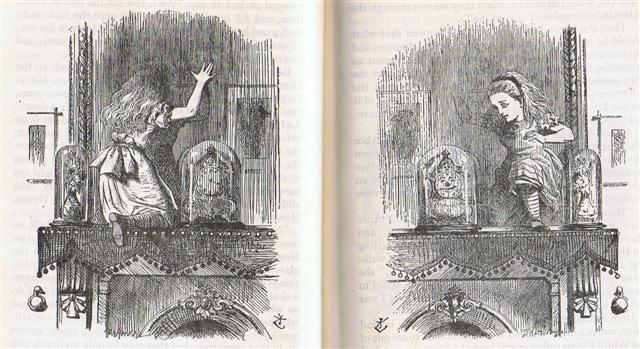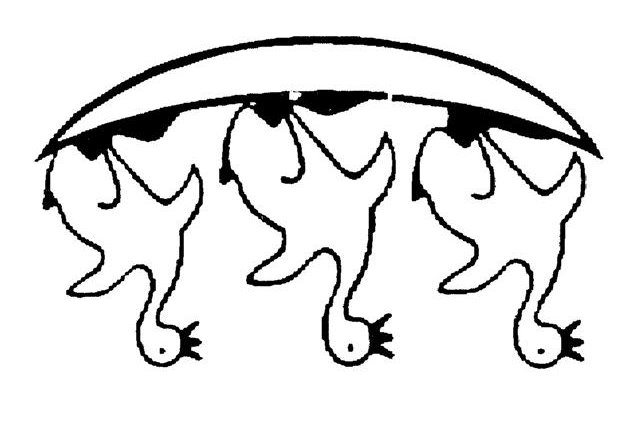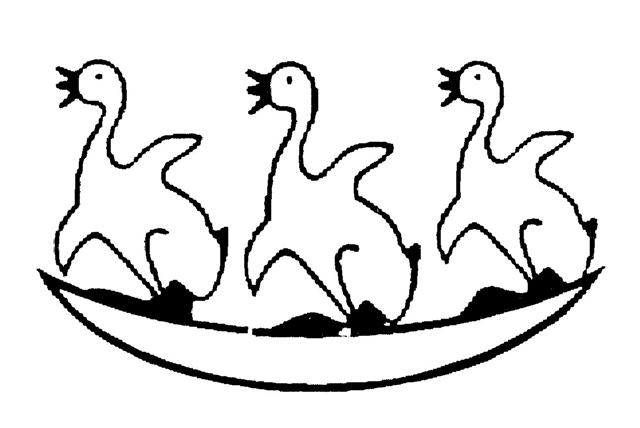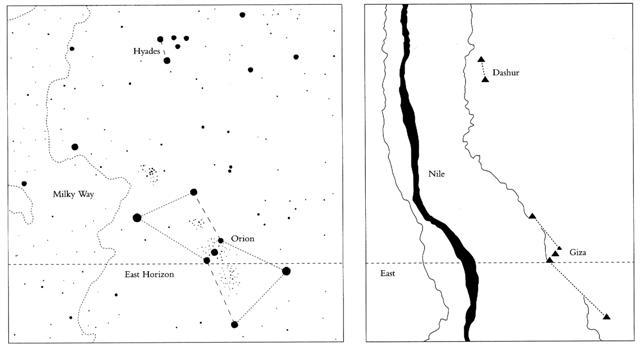For the C text we have established there was a sequence of 378 days (the synodic cycle of Saturn) which possibly was used for illustrating how Saturn was giving his time measures to Jupiter:
20 * 365.25 = 7305 days. 7305 / 378.09 = 19.32 and 7305 / 398.88 = 18.31, i.e.:
0.32 * 378.09 = ca 121 (= 11 * 11) days and 0.31 * 398.88 = ca 124 (= 4 * 31 = 372 / 3) days. Day 123 after 0h was a day of π, because JULY 22 could be read as 22 / 7:
Could we now not eliminate such dates as September 21 and September 24 and instead use the heliacal and nakshatra dates at the time of the Bull? This would make it easier to put in parallel the texts on the C and G tablets. However, for the G tablet there seems to be a correlation between the glyphs and the dates at the time of rongorongo, for instance in the position of heliacal Rogo, either to be read as marking heliacal Wezen at July 6 (*107 = 472 - 365) or as marking heliacal Sirrah at March 21 (80). At the time of the Bull the corresponding date for heliacal Wezen would have been 64 days earlier, viz. in day 123 (MAY 3 - cfr the joint remainder 123 days in my Saturn / Jupiter table above):
And then we have found correlations also with the time of Gregory XIII, for instance:
In the C text above we can similarly infer a correspondence between the September equinox and the beginning of a Saturn cycle. When the Sun went away to the opposite hemisphere in the south darkness took over. In the Babylonian zodiac we can therefore at this equinox probably see both a symbol for the Sun (in his water costume) and a symbol for Saturn. ... While the jaguar was weeping at this, an anteater came along, and the jaguar suggested that they should have an excretory competition. The anteater, however, appropriated the excrement containing raw meat and made the jaguar believe that its own excretions consisted entirely of ants. In order to even things out, the jaguar invited the anteater to a juggling contest, using their eyes removed from the sockets: the anteater's eyes fell back into place, but the jaguar's remained hanging at the top of a tree, and so it became blind. At the request of the anteater, the macuco bird made the jaguar new eyes out of water, and these allowed it to see in the dark. Since that time the jaguar only goes out at night. Having lost fire, it eats meat raw ...
The date OCTOBER 31 at heliacal
Nunki could refer to a position at the end of the 8th
(OCTO) month.
The Sun changed his clothes (appearance) at certain points in his yearly cycle. The Egyptian picture below illustrates how the powerful a.m. Sun at noon was changing his sex and habits into a feebler p.m. Sun with a little pupil (offspring) inside: ... When this tremendous task had been accomplished Atea took a third husband, Fa'a-hotu, Make Fruitful. Then occurred a curious event. Whether Atea had wearied of bringing forth offspring we are not told, but certain it is that Atea and her husband Fa'a-hotu exchanged sexes. Then the [male] eyes of Atea glanced down at those of his wife Hotu and they begat Ru. It was this Ru who explored the whole earth and divided it into north, south, east, and west ...
... from the beginning of mankind sex has been a battle which women win, turning the death of the man (detumescence) into the life of the people (the child). Maori say, 'the genitals of women are killers of men' ...
... His temple-palace was composed of four radiant apartments: one toward the east, yellow with gold; one towards the west, blue with turquoise and jade; one toward the south, white with pearls and shells; one towards the north, red with bloodstones - symbolizing the cardinal quarters of the world over which the light of the sun holds sway. And it was set wonderfully above a mighty river that passed through the midst of the city of Tula; so that every night, precisely at midnight, the king descended into the river to bathe; and the place of his bath was called 'In the Painted Vase', or 'In the Precious Waters'. But the time of his predestined defeat by the dark brother, Tezcatlipoca, was ever approaching, and, knowing perfectly the rhythm of his own destiny, Quetzalcoatl would make no move to stay it. Tezcatlipoca, therefore, said to his attendants, 'We shall give him a drink to dull his reason and show him his own face in a mirror; then, surely, he will be lost'. And he said to the servants of the good king, 'Go tell your master that I have come to show him his own flesh!' But when the message was brought to Quetzalcoatl, the aging monarch said, 'What does he call my own flesh? Go and ask!' And when the other was admitted to his presence: 'What is this, my flesh, that you would show me?' Tezcatlipoca answered, 'My Lord and Priest, look now at your flesh; know yourself; see yourself as you are seen by others!' And he presented the mirror. Whereupon, seeing his own face in that mirror, Quetzalcoatl immediately cried out, 'How is it possible that my subjects should look upon me without fright? Well might they flee from before me. For how can a man remain among them when he is filled as I am with foul sores, his old face wrinkled and of an aspect so loathsome? I shall be seen no more, I shall no longer terrify my people' ...
However, to turn the G tablet around from side a to side b was, it seems, determined by several factors. First we have the inverted ruler in Ga8-24 (°December 31), with Sky (Ragi) at the top and Nuku (Earth) at bottom.
Half a year earlier this type of inversion appears to have been divided into a pair of glyphs 4 days apart - a rising fish in Ga2-13 and a descending fish in Ga2-17 - a phenomenon which resembles what we just have found for the 'bird nest' (possibly the Phoenix place): ... As its end approached the phoenix fashioned a nest of aromatic boughs and spices, set it on fire, and was consumed in the flames. From the pyre miraculously sprang a new phoenix, which, after embalming its father's ashes in an egg of myrrh, flew with the ashes to Heliopolis where it deposited them on the altar in the temple of the sun god Ra ...
The Phoenix was connected with ashes (te kihikihi) and a new fire. Between the end of one cycle and the next there seems to have been 5 dark nights. Beyond June 10 and the maro (dry, June) feathers hanging down in front (often referred to as te kihikihi by Metoro) - the day after El-nath (the Butting One in the Bull) - there evidently were the 3 dark nights of the Great Pyramids (stones) followed by the new fire.
Above the 3 pyramid stars in the Belt of Orion ruled the 3 Heka (λ) tripod stars and below was the Moon Hare (Arneb). ...Al Maisān, the title of γ Geminorum, by some error of Firuzabadi was applied to this star as Meissa [λ Orionis}, and is now common for it. Al Sufi called it Al Tahāyī; but Al Ferghani and Al Tizini knew it as Rās al Jauzah, the Head of the Jauzah, which it marks. The original Arabic name, Al Hak'ah, a White Spot, was from the added faint light of the smaller φ¹and φ² in the background, and has descended to us as Heka and Hika. These three stars were another of the Athāfiyy [tripods used for cooking] of the Arabs; and everywhere in early astrology were thought, like all similar groups, to be of unfortunate influence in human affairs. They constituted the Euphratean lunar station Mas-tab-ba-tur-tur, the Little Twins, a title also found for γ and η Geminorum; and individually were important stars among the Babylonians, rising to them with the sun at the summer solstice, and, with α and γ, were known as Kakkab Sar, the Constellation of the King ... ... The Heka triplet is where we otherwise would have expected to see a bright single star representing Orion's head (when looking from a location in the northern hemisphere) ... λ and the two stars phi furnish an easy refutation of the popular error as to the apparent magnitude of the moon's disc, Colas writing of this in the Celestial Handbook of 1892: In looking at this triangle nobody would think that the moon could be inserted in it; but as the distance from λ to φ¹ is 27', and the distance from φ¹ to φ² is 33', it is a positive fact; the moon's mean apparent diameter being 31' 7''. This illusion, prevalent in all ages, has attracted the attention of many great men; Ptolemy, Roger Bacon, Kepler, and others having treated of it. The lunar disc, seen by the naked eye of an uninstructed observer, appears, as it is frequently expressed 'about the size of a dinner-plate', but should be seen as only equal to a peppercorn ... ... In other lunar zodiacs [than that of the Babylonians] they were the Sogdian Marezānā, and the Khorasmian Ikhma, the Twins; the Persian Aveçr, the Coronet; and the Coptic Klusos, Watery. They also were the 3rd manil Al Hak'ah; the sieu Tsee, or Tsuy He, the Beak, or Pouting Lips, anciently Tsok, which Reeves gave as Keo; and the nakshatra Mrigaçiras or Mrigaçirshā, the Head of the Stag, - Soma, the Moon, being its presiding divinity, and λ the junction star towards Ārdrā [ruled by 'the moist one', Betelgeuze], and its determinant ...
|
|||||||||||||||||||||||||||||||||||||||||||||||||||||||||||||||||||||||||||||||||||||||||||||||||||||||||||||||||||||||||||||||||||||||||||||||||||||||||||||||||||||||||||||||||||||||||||||||||||||||||||||||||||||||||||||||||||||||||||||||||||||||||||||||||||||||||||||||||||||||||||||||||||||||||||||||||||||||||||||||||||||||||||||||||||||||||||||||||||||||||||||||||||||||||||||||||||||||||||||||||||||||||





























